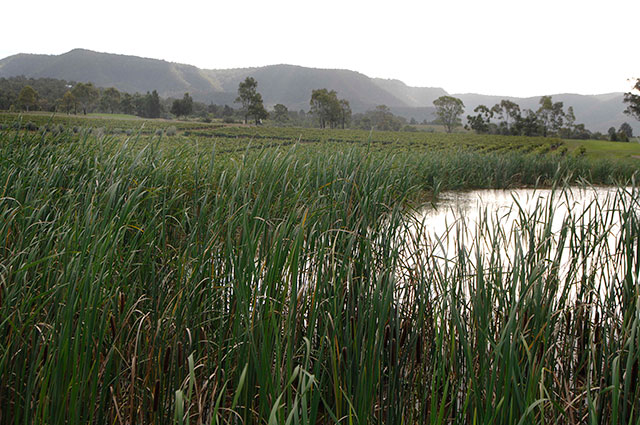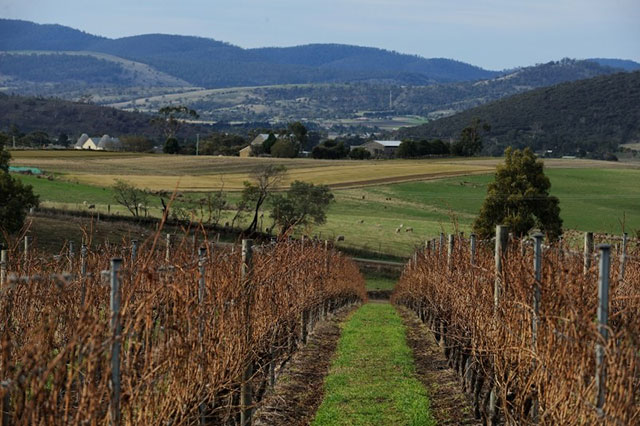Rethinking Australian Wine
By John Lenart in Food on Jun 26, 2015 4:40PM

Photo Credit: John Lenart
For the past several years Australian wine has been faced with an identity crisis. Ask a wine lover what they think about Aussie wines and you'll likely get one of two answers: Over-extracted, high alcohol jam bombs or cheap Yellow Tail plonk. And you know, they wouldn't be entirely wrong. But honestly, when you think about it, those are pretty unfair generalizations. Australia is enormous— four fifths the size of the United States, and its 60 wine producing areas possess just as much variety of terroir as US growing areas. I mean think about it, you'd never clump Napa Valley wines together with Finger Lakes wines. So why are we so apt to do this with Aussie wine?
Australia is home to the oldest shiraz/syrah, grenache and cabernet sauvignon vines in the world. The phylloxera root louse which ravaged vineyards in Europe and the United States has never been a significant issue down under. This allowed these vines to get really old and develop deep diving root systems, which provide grapes of exceptional quality.
While Australia has been exporting wines since the mid 1800s, it never was viewed as a hotbed of quality wines. Australia saw an influx of European immigrants after World War II, bringing with them a wealth of wine growing knowledge. Australians’ taste for finer wines grew rapidly, even though most of its exports remained sweet fortified wines. The industry continued to change and grow and the export of quality wines grew.
In 1995, Wine Spectator named the 1990 Penfolds Grange Wine of the Year. John Duval, Penfolds Chief Winemaker at the time, told me, “When Wine Spectator announced the award in December of 1995 we had almost sold out of the 1990 Grange because it had been released in March. Demand and prices soared.” Penfolds Grange is known to be a dense wine, big on the palate, with a long finish, and is one of the world's most sought after wines. Many Americans began to search out similar “big” wines from South Australia.
In the year 2000, bulk wine producer Casella Wines introduced the Yellow Tail brand which, by the year 2003, became the number one selling import into the United States. Soon after many other cheap Australian critter named brands followed.
Unfortunately, Aussie wines became known as either cheap plonk with cute names or high alcohol fruit bombs, and nothing in between. At a recent industry tasting put on by the trade organization Wine Australia, which I attended as a guest, these stereotypes were quickly proven wrong.
Mark Davidson, Global Education Manager for Wine Australia, and his guest John Duval, winemaker of John Duval Wines, and winemaker of the legendary 1990 Penfolds Grange, led guests through the tasting. To address the highlights of the story of Australian wines, the tasting was divided into three flights: history, evolution and revolution. Each flight consisted of six wines. Here were my favorites along with some tasting notes.
History:
This flight looked at wines made from old vines and wines that featured classic Australian style. In general, Australian wines have historically been light in oak to highlight the quality of fruit.
Brokenwood IRL Semillon, 2005, Hunter Valley - The green hues of this youthful looking wine hid its mature age. Aromas of green apple and dusty white roses, and a slight nuttiness are highlighted with a nice weight and flavors of apple and citrus with a light limestone minerality. Bright fruit and acidity for a wine of this age. The current 2013 vintage is available at Binny's for $17.
Langmeil “The Freedom 1843” Shiraz 2012, Barossa Valley - Medium crimson color moving toward purple. This wine, from what is believed to be the oldest shiraz vineyards in Australia, planted in, well...1843, shows aromas of dried plum, dried red berries and hints of cola. The heavy mouth feel of this silky wine comes through with flavors of dried berries, and a touch of cedar and clove. Available at Plum Market for $120.
Evolution:
This flight addressed how things have changed in Australian wine making. It wasn't until 1970 when the first commercial chardonnay was made in Australia. But it wasn't very good. “We wanted to do what Burgundy does, but it wasn't right for Australia. It wasn't until we stopped trying to do that and just tried to make really good chardonnay that Australia began to produce chardonnays like burgundy,” according to Mark Davidson. When it comes to the evolution of reds “Syrah reflects terroir more readily that cabernet,” according to Duval.
Tolpuddle Chardonnay 2013, Tasmania - Super bright yellow color with a delicate aroma. This Chablis-like chardonnay features bright acidity and flinty minerality with delicate lemon and green apple fruit leading to a slightly creamy, finessed finish with lingering citrus. Highly limited in Chicago. Restaurants only.
John Duval Entity Shiraz 2012, Barossa - The deep ruby, almost inky color says “Get ready for something big!” Aromas of dried black and blueberry give way to dried herbs and spiciness. The silky and luxurious weight of the wine leads the way to balanced dark fruit flavors backed up by good acidity and tannin, all leading to a sexy finish. Available at Schaefer's $42.
Revolution:
This flight highlighted Australian wines that depart from convention and break the stereotypes often associated with wine from down under. When asked which flight guests liked the most, the majority of attendees liked this flight, which I saw as the geekiest of wines presented.
John Duval Plexus White 2013, Barossa Valley - This blend of marsanne, rousanne and viognier shows a bright pale straw color and aromas of pear, honeysuckle and white pepper. Flavors of white peach, pear and honey are backed up with medium acidity. Available from on-line sources for $30.
Route du Van Dolcetto-Shiraz 2012, King Valley - This medium ruby colored wine is a fun one. Rather than jammy and brooding, this wine leads with aromas of violet and cherry, and playful flavors of fresh berries giving way to dried herbs. Fine tannin and good acidity provide just a touch of a serious backbone. Serve this baby cellar temp and hit the patio! Available from on-line sources for $19.

